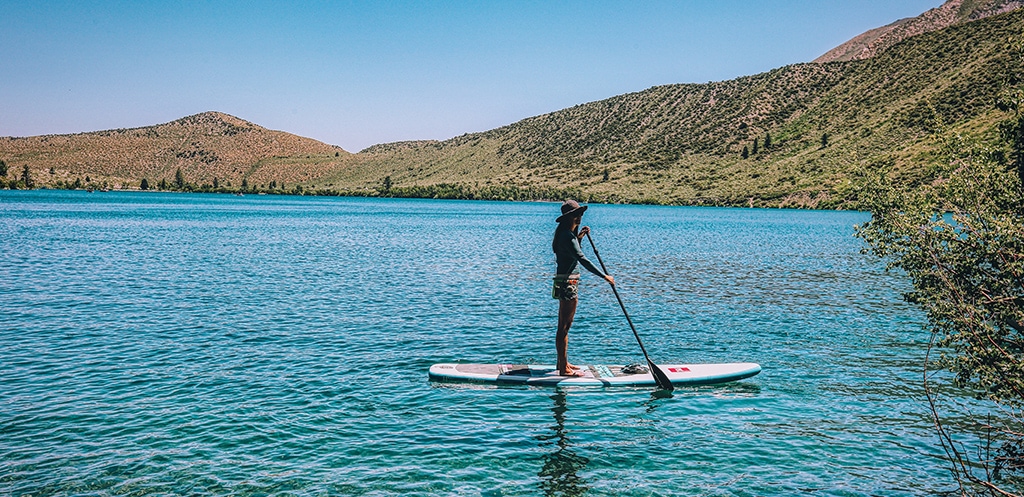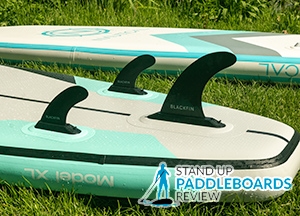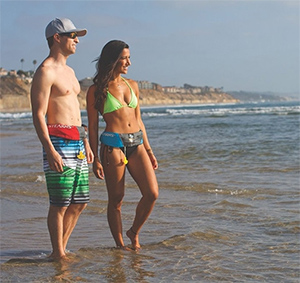Stand up paddle boarding is a simple and fun full-body workout that has tons of health benefits. Who wouldn’t want to try it?
Most, if not all, activities that happen in or on the water require you to be a strong swimmer.
So, can you paddle board if you can’t swim? This is probably the main question on your mind if you’re curious about SUP but are a weak swimmer or can’t swim completely. The simple answer is yes, you can stand up paddle board even though you can’t swim.
However, the water is powerful and it can be dangerous. Here is everything you need to know about paddle boarding when you can’t swim.
Key Takeaways
- You can stand up paddle board even if you can’t swim but it is not advisable.
- Paddle boarding in shallow water is not recommended as it can damage your board and is not safe for falling in.
- Waist-deep water is much better. You won’t have to worry about damaging your fin, and there are minimal chances of you getting hurt if you fall.
- Always wear your USCG-approved life jacket and leash, regardless of your skill level.
- Have a qualified SUP instructor with you if you cannot swim.
Can You Paddle Board in Shallow Water?
Paddle boarding in shallow water might look like the best solution for non-swimmers, right? It seems safer because drowning in 10- to 20-inch deep water is highly unlikely. You can land upright when you fall too.
It sounds like a great idea in theory. But it isn’t!
Firstly, paddle boards have fins that can be long, especially the center fin in a three-fin setup. It’s the most common setup for all-around boards. The Atoll 11, for instance, has an 8-inch paddle board fin while the Gili Meno has a 9-inch fin.
With your weight on the stand up paddle board, the fin can easily drag along the bottom, causing damage to your board. Your paddling session will be ruined and you’ll incur costs you hadn’t planned for.
Secondly, falling off of a SUP board is expected, more so for beginners. Falling in ankle-deep water can be unsafe because there’s not enough water to cushion you. You could hit your head or land awkwardly and get hurt.
So while shallow water may make you feel safe, it’s not that great for you or your paddle board.
How Much Water Is Enough for a Non-Swimmer to Learn SUP?
Knee-deep or ankle-deep waters may not be a great idea but that doesn’t mean that you have to go to the deepest spot to learn.
Shallow water can damage your SUP and it is not safe for falling in. Deep water requires swimming skills and can also be unsafe for weak swimmers. Luckily, you can find a sweet spot.
You want water that is deep enough for a safe fall, but not too deep that you can’t come up for air and get back on the board when you fall in.
Waist-deep water is much better. You won’t have to worry about damaging your fin, and there are minimal chances of you getting hurt. It is also possible to remain upright or find your way up when you fall.
Chest or neck-height water is also ideal for learning SUP if you don’t know how to swim. It is great because you can learn how to properly fall off your paddle board (yes, it is a necessary skill for paddle boarding).
You may not land with your body upright, but the water is not that deep so you shouldn’t worry, more so if you have a life jacket because it will keep you afloat.
Make sure you have an instructor with you to be on the safe side.
Can A Personal Flotation Device and Leash Adequately Protect a Non-Swimmer?
Regardless of where you paddle board and your skill level, safety equipment is a must-have. You need to have a life jacket and a leash on at all times when SUPing.
A personal floatation device (PFD) offers buoyancy, keeping you afloat when you fall in the water.
A leash is another key safety accessory. It ensures that you aren’t separated from your SUP when you fall off. A paddle board can quickly drift away and you’ll be stranded before you know it. With your SUP, you’ll have a floating surface to keep you out of the water and help you get to the shore.
With a PFD to keep you above the water and a leash to make sure you can get back on the SUP, it may seem like you don’t need swimming skills, right?
Well, you wouldn’t want to depend on your leash and PFD 100%. Suppose you have a manual inflatable PFD. With zero swimming skills, you may not even be able to activate and inflate it.
There are a few things you need to master such as treading water, holding your breath, and turning your face up. These can make a huge difference and save your life, especially in a worst-case scenario, so while they seem simple – they’re very important.
Practice the skills to the point where they come to you naturally and always wear a USCG-approved SUP PFD and leash when paddle boarding.
The Best Way to Learn Paddle Boarding If You Can’t Swim
First, you have to find a good location. You need shallow, calm waters; a bay or lagoon would make the best location. The water should be thigh-high or waist-high so you won’t need to swim if you fall in. You can simply stand and get back on your paddle board without panicking.
Secondly, it is advisable to have a qualified instructor with you. The water can be unpredictable; you want to have someone to guide you and ensure that you’re safe. They’ll teach you a few water skills and, hopefully, make you a better swimmer.
Another benefit of having an instructor is so that they’ll show you proper basic SUP skills. If you start off with the wrong paddling techniques, it will be harder to break the habits later on. It is good to start off doing it right.
Thirdly, you should get the right paddle board for a beginner. Your first board should be stable so you don’t spend more time in the water than on the board. Remember you want to avoid swimming.
Look for a paddle board that is at least 33 inches wide and 10’6 to about 11’6 long. Most beginner and all-around paddle boards fall here.
View Swimming As a Part of SUP and Learn
You can’t fully explore stand up paddle boarding if you can’t swim. SUP is broad and there are many ways to have fun on your paddle board. If you don’t know how to swim, you can only SUP in shallow still waters, and usually under supervision.
Many instructors offer paddle boarding classes as well as swimming lessons. Don’t separate SUP and swimming.
Final Thoughts
You can paddle board if you can’t swim, but it isn’t recommended, and it will hamper your SUP experience. You have to do it in shallow, calm waters, about waist-deep and with an instructor present. Deeper waters will require swimming skills, like how to tread water and hold your breath – skills that you may not have.
So, while you can go paddle boarding without knowing how to swim, you should still aspire to learn. This will allow you to fully explore SUP and get the most of it.
Always wear your USCG-approved life jacket and leash, regardless of your skill level.
Happy paddling!



